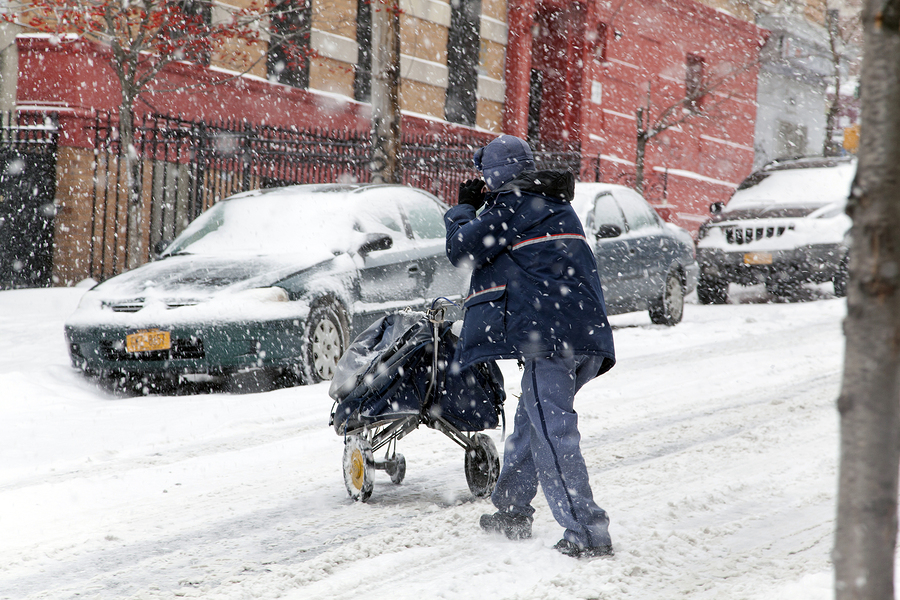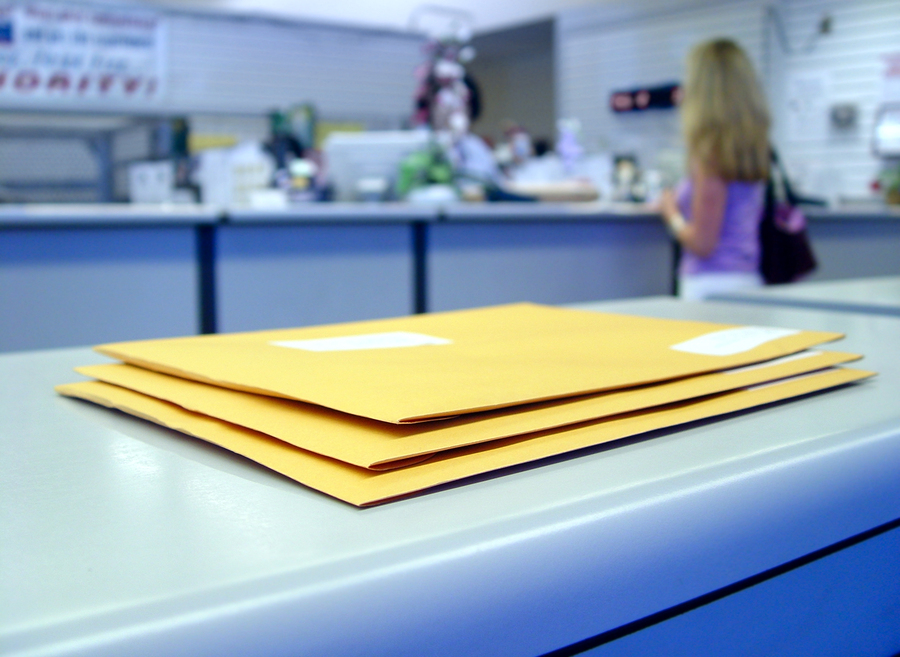Post Office Clerks & Mail Carriers
Work for the Post Office
Post Office Clerks
Clerks, more commonly referred to as mail handlers, unload the sacks of incoming mail; separate letters, parcel post, magazines, and newspapers; and transport these to the proper sorting and processing area. In addition, they may perform simple canceling operations and rewrap packages damaged in processing after letters have been put through stamp-canceling machines.


Clerks operating electronic letter-sorting machines push keys corresponding to the ZIP code of the local post office to which each letter will be delivered; the machine then drops the letters into the proper slots. Window clerks
A growing proportion of clerks operate optical character readers (OCRs) and barcode sorters, machines that can “read” the address and sort a letter according to a code printed on the envelope. Others sort odd-sized letters, magazines, and newspapers by hand. Finally, the mail is sent to local post offices, sorted according to delivery route, and delivered.
According to the Bureau of Labor Statistics’ Occupational Outlook Handbook there are 76,300 postal clerks nationwide. The median annual wages for postal clerks in May 2021 was $52,900. All states employ clerks at thousands of locations with California employing the largest number, 7,480. The media wage for mail carriers was $52,440, and $48,550 for mail sorters and processors.
Post Office Clerk Menu
- Nature of Work
- Working conditions
 Applying For Postal Clerk Jobs
Applying For Postal Clerk Jobs- 474 Postal Exam
- Post Office Jobs Web Site Guide – Guide for finding & applying for job vacancies
- Clerk Jobs – All sectors
- Other Occupations
Nature of Work
Clerks and carriers are distinguished by the type of work they do. Clerks are usually classified by the mail processing function they perform, whereas carriers are classified by their type of route; city or rural. About 350 mail processing centers throughout the country service post offices in surrounding areas and are staffed primarily by postal clerks.
Postal clerks at local post offices sort local mail for delivery to individual customers and provide retail services such as selling stamps and money orders, weighing packages to determine postage, and checking that packages are in satisfactory condition for mailing. Clerks also register, certify, and insure mail and answer questions about postage rates, post office boxes, mailing restrictions, and other postal matters. Occasionally, they may help a customer file a claim for a damaged package.
Once the mail has been processed and sorted, it is ready to be delivered by mail carriers. Duties of city and rural carriers are very similar. Most travel established routes delivering and collecting mail. Mail carriers start work at the post office early in the morning, where they spend a few hours arranging their mail for delivery and taking care of all other details. Carriers may cover the route on foot, by vehicle, or a combination of both. On foot, they carry a heavy load of mail in a satchel or push it in a cart. In some urban and most rural areas, they use a car or small truck. Although the Postal Service provides vehicles to city carriers, most rural carriers use their own automobiles. Deliveries are made house-to-house, to roadside mailboxes, and to large buildings. such as offices or apartments, which generally have all the mailboxes on the first floor.

Besides delivering and collecting mail, carriers collect money for postage-due and c.o.d. (cash on delivery) fees and obtain signed receipts for registered, certified, and insured mail. If a customer is not home, the carrier leaves a notice that tells where special mail is being held.
After completing their routes, carriers return to the post office with mail gathered from street collection boxes, homes, and businesses. They turn in the mail receipts and money collected during the day and may separate letters and parcels for further processing by clerks.
The duties of some city carriers may be very specialized; some deliver only parcel post while others collect mail from street boxes and receiving boxes in office buildings. In contrast, rural carriers provide a wide range of postal services. In addition to delivering and picking up mail, they sell stamps and money orders and accept parcels, letters, and items to be registered, certified, or insured.
All carriers answer customers’ questions about postal regulations and services and provide change-of-address cards and other postal forms when requested. In addition to their regularly scheduled duties, carriers often participate in neighborhood service programs in which they check on elderly or shut-in patrons or notify the police of any suspicious activities along their route.
Postal clerks and mail carriers are classified as casual, part-time flexible, part-time regular, or full time. Casual workers help process and deliver mail during peak mailing or vacation periods. Part-time flexible workers do not have a regular work schedule or weekly guarantee of hours; they replace absent workers and help with extra work as the need arises. Part-time regulars have a set work schedule of less than 40 hours per week. Full-time postal employees work a 40-hour week over a 5-day period.
Clerk & Carrier Working Conditions
Post office clerks usually work in clean, well-ventilated, and well-lit buildings. However, other conditions vary according to work assignments and the type of labor saving machinery available. In small post offices, mail handlers use hand trucks to move heavy mail sacks from one part of the building to another and clerks may sort mail by hand. In large post offices and mail processing centers, chutes and conveyors move the mail, and much of the sorting is done by machines. Despite the use of automated equipment, the work of mail handlers and postal clerks can be physically demanding. These workers are usually on their feet, reaching for sacks and trays of mail or placing packages and bundles into sacks and trays. Mail handlers and distribution clerks may become bored with the routine of moving and sorting mail. Many work at night or on weekends because most large post offices process mail around the clock, and the largest volume of
mail is sorted during the evening and night shifts.
Window post office clerks, on the other hand, have a greater variety of duties, frequent contact with the public, and rarely have to work at night. However, they may have to deal with upset customers, and they are held accountable for the assigned stock of stamps and for postal funds.
Most carriers begin work early in the morning, in some cases as early as 4 a.m. if they have routes in the business district. A carrier’s schedule has its advantages, however: Carriers who begin work early in the morning are through by early afternoon, and they spend most of the day on their own, relatively free from direct supervision.
Carriers spend most of their time outdoors and deliver mail in all kinds of weather. Even those who drive often must walk when making deliveries and must lift heavy sacks of parcel post items when loading their vehicles. In addition, carriers always must be cautious of potential hazards on their routes. Wet roads and sidewalks can be treacherous, and each year numerous carriers are bitten by unfriendly dogs.
“Post Office Jobs” is the only study guide and job finder that includes guidance on how to successfully handle the postal pre-appointment interview, prepare for the 473 Battery Test, shows you how to find job vacancies in your area, and it presents complete position descriptions for the Post Office’s top 25 job classifications. It also includes seven other exams for clerical, technician, custodian, auto mechanic, and other occupations.
Job seekers looking for good pay with excellent benefits should pursue the postal service job market and use this book’s resources to begin their personal job search. The Job Hunter’s Checklist will take you step-by-step through the process.
Also, explore and apply for all job vacancies in the government and private sectors to improve you chance of employment. You can post your resume online at no cost to expand your job search.
> Applying for Postal Clerk & Mail Carrier Jobs
When applying for postal clerk positions the applicant must pass the 474 Virtual Enry Assessment Exam. During the online application process, the applicant completes numerous forms and provides work and education history.
Caution: The Postal Service does not charge anyone to take a postal exam.
Follow the Application Procedures listed on this site to find post office clerk positions in your area.
